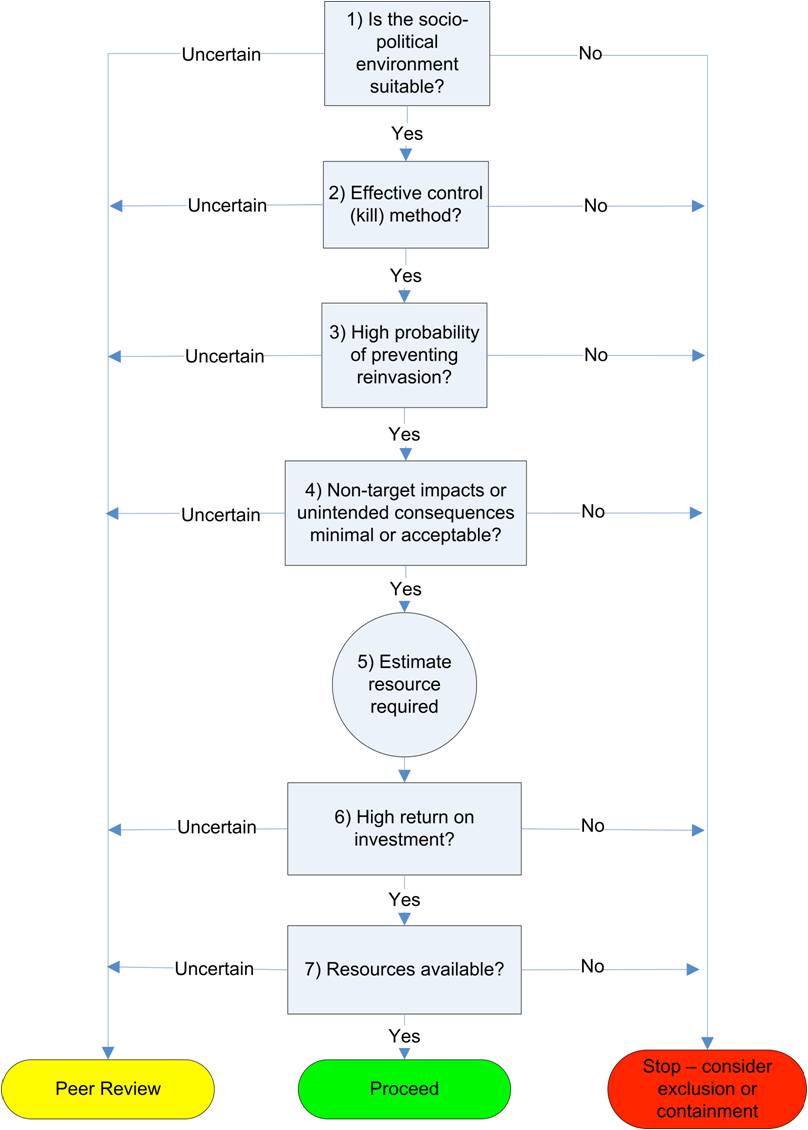A common theme in the articles on invasive species in the September 2011 issue of Science Chronicles is the need to prioritize scarce resources when deciding whether or not to manage invasive species. Despite lively differences of opinion, all contributors agreed
that, to justify spending resources on control efforts, (1) the species must be causing serious economic or environmental harm or harm to human health, (2) the control efforts should have a high probability of success, and (3) the control efforts should give a good
return on the investment. Control projects should also result in long-term maintenance or restoration of the viability/health/resilience of desired species, natural communities, and/or ecosystem processes, as was emphasized by TNC’s Site Weed Management Plan
Template in 1999.
In practice, it is often difficult to decide if all these criteria are met. A number of tools have been developed to prioritize invasive plant species for management at a site; however, these tools provide little assistance in determining if controlling an invasive is or is not feasible and likely to succeed when all factors in a given situation are considered. But we now have a tool to help us make the crucial decision to control or not to control.
Born out of an internal spirited debate on when to implement invasive plant control, a Nature Conservancy working group in New York completed the Invasive Plant Management Decision Analysis Tool (IPMDAT) in June 2011. The purpose of the IPMDAT is to assist conservation project managers in deciding if an invasive plant control project is warranted (i.e., that the non-native species causes significant impact or harm); feasible; has a high return on investment; and will lead to a successful conservation outcome. Using this tool makes our decisions on invasives control more transparent, understandable and fully documented. As a result, we expect to undertake
fewer invasive control projects and spend our resources more strategically.
The IPMDAT is comprised of a strategy-selection decision tree (see Figure 1 at the end of this piece) and three control-strategy decision trees (eradication, containment/ exclusion, and suppression) as well as associated worksheets and documentation. The strategy-selection tree is used to document the harm caused by an invasive plant species and to identify the appropriate control strategy based on the plant’s abundance and distribution. Subsequent trees are used to determine whether control is feasible given the socio-political environment, biological attributes of the plant, effectiveness of control methods, risk of non-target impacts or unintended consequences, and available resources — including financial commitment. If the project is determined to be feasible, then the user is asked to weigh the costs and benefits of the control project. Lastly, a preand post-control monitoring plan is required for a control project to proceed.
The IPMDAT contains three potential control strategies: eradication, containment/ exclusion, and suppression:
Eradication – goal is to eliminate all individuals and the seed bank from an area with the low likelihood of needing to address the species again for the next 10 years.
Containment/exclusion – a project which aims to prevent infestations of invasive species from spreading to uninfested areas.
Suppression – goal of project is to reduce an invasive plant population in size, abundance, and/or reproductive output below the threshold needed to maintain a species or ecological process.
It is emphasized that long-term containment/exclusion and suppression projects should be entered into with caution to be sure the benefits outweigh the costs; that internal support is in place (i.e. from a state program director of conservation programs or equivalent position); and that needed resources are available and secure. The IPMDAT has four possible outcomes:
-
Proceed with control (project has conservation value and a high probability of success.
-
Stop – secure sustainable funding before proceeding.
-
Stop – control not feasible and/or not warranted.
-
Peer-review required – feasibility and/or conservation value is uncertain.
In New York State, we are currently using IPMDAT to evaluate new and current invasive plant control projects and training state agencies and organizations to use the tool. Additionally, we are sharing more details about the tool at the All-Science TNC Conference and other venues. Our hope is that other TNC programs and partners will see value in this tool and use it to evaluate their projects as well.
We view development of this tool as an iterative process. The tool will be updated as new information becomes available and as users provide input. We may also incorporate new quantitative approaches to evaluate the likelihood of success for different control
strategies as well as to evaluate economic costs and benefits. With minimal modifications, the IPMDAT could also be used for forest pests, aquatic invaders and other non-plant invasive species. We envision that use of the IPMDAT now and in the future will lead to more effective and efficient use of resources as well as a high percentage of successful projects within the Conservancy. We envision even greater value if adopted across the entire organization, fostering better decisions and greater communication across political boundaries.
To review or use the IPMDAT go to: http://conserveonline.org/library/an-invasive-plant-management-decisionanalysis/
view.html
Figure 1: IPMDAT Strategy-Selection Decision Tree

Acknowledgements
I would like to thank Marilyn Jordan, Hilary Smith, Gregg Sargis, Troy Weldy and rest of the NYS Invasive Species Team for their hard work in developing the IPMDAT and contributions to this article.
Image: Volunteers removing invasive Scott’s Broom weeds from Mima Mounds Natural Area Preserve, Washington State. Image credit: WAstateDNRDepartment of Nature Resources/Flickr.